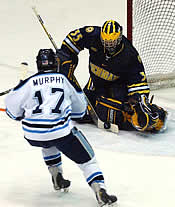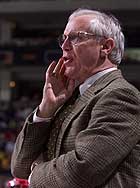Between golf and some Molsons, they do talk turkey now and then at the annual AHCA Coaches Convention in Naples, Fla., going on this week. What’s on the agenda, who’s to say. But it wouldn’t surprise us if these things were:
Stop the Presses
Enough of the e-mails already, please. USCHO, and myself in particular, were swamped with e-mails about the host school issue in this year’s NCAA tournament. This year, once again, Michigan and Minnesota got to host regionals, and play NCAA games, in their own buildings.
The e-mails ranged from reasoned concern, to suggestions for solutions, to every conspiracy theory under the sun. One accused USCHO of being “in on it” for failing to take the NCAA to task over the issue.
There’s a very simple reason for writing so little about the topic: a) it’s nothing new; and b) we understand the dilemma and the reasoning for the decision.
Obviously, however, a lot of people don’t. It’s not just a matter of honest disagreement, in many cases there’s just complete misunderstanding of the process. Even the well-intentioned e-mails often display simple ignorance about the topic.
For some reason, there are a significant number of people that believe Michigan was awarded the host site after the selection of the teams. Others knew the host sites were picked in advance, but didn’t know about the rule which forces the NCAA to keep host school teams in that region.
So, to everyone out there: You don’t need to tell us anymore how unfair it is that Michigan and Minnesota get to host regionals. We all know that, the NCAA knows that, and Michigan and Minnesota know that. And we also know that it’s not done this way in men’s basketball.
Tell us something new. And I don’t mean a six-page diatribe on how the NCAA conspires in favor of big-money schools.
Give us a solution.

Host sites are awarded years in advance. Why are Minnesota and, in particular, Michigan so often hosts? Because they are often among the few schools to put in bids.
The NCAA doesn’t select a host site from a place that doesn’t put in a bid!
OK, that takes care of major ignorance gap Nos. 1 and 2.
It also must be realized that switching to two regionals in the East and West, as was done for the new 16-team tournament, just compounds the problem. That makes it more likely each year that Michigan will get a bid, because we need two West sites, and there’s only so many to choose from.
Why are there so few bids out West? Because the schools are so much more spread out, and there just aren’t a lot of quality neutral-site buildings. More importantly, there aren’t enough buildings where you could draw enough fans to support the event. That’s why few sites actually bid for it. And if they don’t bid, the NCAA can’t award it to them.
And no one is stopping other places from bidding. In fact, in the coming years, the new buildings at Denver, North Dakota and Colorado College will get West Regionals. And, thanks in part to new rules relaxing the requirements for hosting, and the encouragement of the NCAA, more and more facilities are putting in bids. So the situation should improve itself.
In the mean time, you can’t blame Michigan for putting in bids, and you can’t blame the NCAA for putting them there.
Of course, there is the argument that hockey should be like men’s basketball, and if Michigan is hosting the event, the team should not be allowed to play there.
But hockey is not basketball, and I agree with the NCAA’s decision to let teams of host schools play in their building.
Unfortunately, it’s just impossible to draw flies at some regionals if a local team isn’t there. And the same would be true for the East, too, but there are so many schools within striking distance of whatever facility it is in, that you never run into that problem. And even if a school like BU hosts a regional in Worcester, they don’t really get a home-ice advantage because other team’s fans come too.
Again, the problem out West is, the schools are too spread out. I’d rather see Michigan get an unfair advantage than see a dead building for the event. It’s just a fact of life that hockey can’t yet guarantee a sellout for regionals without some local flavor.
I think you will see things change in the coming years, with more venues putting in bids.
It’s not like anyone hasn’t tried to come up with the solution. There just aren’t any that make sense.
Well, I do have one idea. Call it radical, if you want.
Why not re-draw the boundaries of what you consider the second “West” regional? Instead of “Midwest” you could call it “North” and include places like Pittsburgh, Buffalo and even Rochester in the mix. More precisely, let’s have two regionals in New England, one in the Far West, and one in the “Great Lakes” area.
There’s no law that says there must be two “Western” regional sites. I think this is a holdover from the olden days, and considering how much we’re trying to get rid of the parochialism in college hockey, I think this would be a good move and solve a few problems.
Something to think about.
Downsizing
New Hampshire has been investigating the possibility of downsizing its rink, from Olympic size of 200×100, to something closer to NHL-size 200×85.
The Whittemore Center was built right around the peak of the Olympic-sized craze. The conventional wisdom of the time was, all new arenas should go Olympic sized because it will open the game up more.
But a funny thing happened on the way to the Forum … coaches came to the conclusion that Olympic-sized ice made the game slower, especially for just an average game. With more room to skate, there’s less urgency to move the puck, there’s less hitting, and there’s more play on the perimeter.
Sure, a lot of people like the wide open play, but a) that requires two good teams. And b) a lot of people like hitting too.

“If you have two good, fast-skating teams, playing on a big sheet is a great game,” says Hockey East commissioner Joe Bertagna. “But if you have a mediocre team on a big sheet, it doesn’t help the game.”
Further, because the NCAAs are mainly played on NHL-sized ice these days, it behooves everyone to play on that surface all year.
“It’s important to keep the same ice surface consistent in the Frozen Four with the regular season,” says Boston College coach Jerry York.
The late Maine coach, Shawn Walsh, never liked the flip-flopping in ice surfaces.
“It’s a mistake to play games on different surfaces,” Walsh said at the Frozen Four three years ago. “What you play on in the Frozen Four is what you should play on in the Regionals too.”
Of course, this hasn’t hurt Minnesota the last two seasons.
“I think people make too much of it,” says former Wisconsin coach Jeff Sauer. “I think it’s a great learning experience for a young hockey player and great learning experience for a coach, because you have to do different things on different size sheets. In [the WCHA], there’s five or six Olympic-sized rinks and you’re adjusting all the time.
“[But] the game is definitely more exciting on a smaller ice sheet. Not a lot of us have enough skill to play on the Olympic-sized sheet. From a development standpoint of a hockey player, to play on both size sheets and know what it’s all about is a real good experience for them.”
The trend is clearly away from Olympic-sized ice. The thinking now is, since college hockey doesn’t use the red line, that in and of itself is enough to open the game up vis-a-vis the pros, without the need for Olympic-sized rinks.
New rinks in Denver, North Dakota, Wisconsin and elsewhere have moved to NHL-sized surfaces. The new rink being built at Boston University will also by 200×85. The ECAC moved its tournament from Lake Placid to the NHL-sized Pepsi Arena in Albany, N.Y.
“Other schools in the WCHA have Olympic-size rinks,” says North Dakota coach Dean Blais. “It is a more of a puck possession game with less forchecking, which makes the game less entertaining.”
New Hampshire — which has adjusted from a wide-open, run-and-gun team, to a more balanced attack in recent years — is still debating the issue. But let’s not forget another enticement … money. UNH could fit more seats with a smaller ice surface, and considering it sells out all the time, that would mean a good chunk of change.
One sticking point is, it appears there’s a rule that requires new arenas to be at least 200×90, but if there is such a rule, it really hasn’t been followed.
Says Sauer, “Two hundred by 85 is a good size, 200×100 is too big; 200×90 might be the best place to go.”
About Face
Speaking of things that used to be in vogue, there’s face shields.
Actually, they were pretty much never in vogue for players and coaches, but they were mandated by the NCAA in 1980. Seemingly ever since, the coaches have been trying to get rid of them.

This isn’t a new topic, but I did have a chance to speak recently with Boston University coach Jack Parker about it. In case you don’t know, he is by far the most outspoken about the issue, even though all the coaches are behind him. In fact, every few years, they vote on the issue, and the coaches are always unanimous against face shields. But, Parker says, the NCAA won’t allow the rule to change.
Parker became more outspoken since the Travis Roy incident in October, 1995. Roy was left paralyzed when he fell awkwardly into the boards after colliding with an opponent.
Though Roy’s case was more a fluke than a dangerous play, it was the catalyst for Parker to continue to speak out about face shields.
“The full face shield absolutely ruined the game,” Parker says. “It was supposed to make game safer because you would have less eye injuries, but it made it ferocious. The game is much more dangerous today than it was in 1980 and it’s all because of face masks. Sticks are up higher, guys are running people into the boards … there’s a lot more severe injuries than there were facial cuts.
“We have more people in wheelchairs than ever lost an eye. … It’s done just the opposite of what they’ve hoped for.
“What happens is, you can’t see. The full face shields takes away your peripheral vision. You constantly have to look down more. When looking down more, you’re blindsided more, and in any sport when you’re blindsided, you get hurt badly. And that’s what happened, and I think it’s too bad we can’t seem to [change the rule].”
Cornell coach Mike Schafer concurs that the NCAA is being shortsighted in mandating full shields.
“There’s players on the ice that are very vicious with their stick,” Schafer says. “Without the face mask, they don’t get involved in any scrums because they’re afraid to. There’s more respect for each other with high hits to the head.
“Everybody understands the value of having them on, but only hockey people understand the value of not having them on.”
This is a far better argument than the other one you often hear: “There wouldn’t be as much chippiness if they allowed fighting in college hockey.” Oy! Nothing makes my blood boil more than that lame argument. And it doesn’t just come from fans, it comes from many players, too.
And you know what … I have all the respect in the world for anyone who has played pro or college ice hockey. I haven’t. But there is nothing anyone can say that will convince me that allowing fighting reduces dangerous stick penalties and other dirty hits.
This is way too long a discussion to get into right now, but I’ve seen enough minor league hockey, where fighting is rampant and there is an abundance of cheap stick work.
On the other hand, I completely buy Parker’s argument, 100 percent. And I’ve even played in organized leagues as a kid where I had to wear a full shield, and I hated it.
“The only reason we have the face masks is because of lawyers and the threat of lawsuits,” Parker says. “And sooner or later, someone is going to wheel down in a wheelchair and wind up in a courtrom and sue the NCAA, and that’s how we’re going to get rid of it.”


